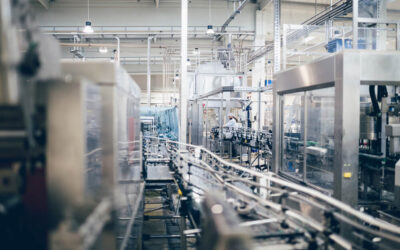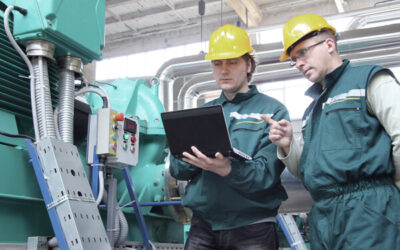From virtual assistants that can answer questions, to autonomous drones that can fly and unpack boxes, AI is transforming the way we work and the tools we use in our everyday jobs. The Tech giants are driving the adoption of advanced technologies in industry verticals thanks to continuous research and innovation.
Blog
Digital Manufacturing
Stressed Supply Chains: Can AI Save Them?
All Content, Digital Manufacturing
The supply chain continues to dominate corporate discussion. Disruptions to the supply chain in the wake of the COVID-19 pandemic have had ripple effects far beyond what anyone could have imagined in the early days of 2020. Today, these effects are well understood. Experts are now looking for ways to make supply chains more resilient and agile. Artificial intelligence is often hailed as the solution to all of the supply chain’s woes. Is it really the panacea we need?
Artificial Intelligence Trends Changing the Industrial Landscape
All Content, Artificial Intelligence, Digital Manufacturing
With 91.5% of leading businesses investing in AI on an ongoing basis, companies that refuse to embrace the future may find themselves being outpaced by competitors. As artificial intelligence offerings continue to expand, companies will need to increase their use of technology in the workplace to maintain relevancy in the competitive industrial sector.
How Is AI Impacting Manufacturing in 2022?
All Content, Artificial Intelligence, Digital Manufacturing
By 2030, it’s thought that AI will make up $15.7 trillion of the global economy, and it is expected to have a particularly profound impact on manufacturing in the coming years. Here is how AI is shaping the manufacturing sector in 2022 and beyond.
Augmented Reality for Industrial Use Cases
Aerospace and Defense, All Content, Digital Manufacturing, Research
Augmented reality, or AR for short, is quickly becoming a vital tool in industrial organizations. This futuristic technology has become much more accessible in recent years, to the point where even small and medium-sized businesses are looking to implement it in their operations. Is augmented reality really necessary for industrial companies, or is it a short-term fad that will fade out? We’re going to examine how industrial businesses are using augmentation today.
Why Aerospace and Defense Must Commit to Digital Transformation
Aerospace and Defense, Digital Manufacturing
Most modern tech companies were built upon a digital foundation. However, manufacturing has long fallen behind in this regard. Due to its emergence before the rise of big data and advanced computing power, few aerospace and defense industry companies have succeeded in going fully digital. Nevertheless, those that have done so find themselves reaping great rewards today. Fortunately, it’s not too late for your company to catch up. Every business can achieve a digital transformation with the right tools.
Industry 4.0 Is Increasingly Vital in Aerospace Competitiveness
Aerospace and Defense, Digital Manufacturing, Research
Like other branches of industry, aerospace companies are quickly adopting industry 4.0 technology. Innovations in computers and data analytics in the past decade and a half have brought forth a brand new model of industry. Some are even calling it the fourth industrial revolution! These digital transformation trends cannot be ignored if you want to remain competitive. But what does a digital transformation in aerospace involve, and why is it necessary to start now?
How Does Industrial Automation Integrate With Renewable Energy?
All Content, Digital Manufacturing, Research
The more an industrial operation can leverage automation, the more profitable it will be. Industrial enterprises worldwide have recognized the value of industrial automation, and many are racing to automate as many tasks as possible. Likewise, companies have seen a need to add renewable energy to their infrastructure. This raises an interesting question: how can automation and renewable power work together? These two technologies have a synergy that few others can rival.
Digital Transformation and Energy Production: Making the Leap
All Content, Digital Manufacturing
Energy production companies have operated under similar conditions for nearly a century. Oil and gas extraction, refinement, and subsequent energy generation have not changed dramatically since their inception. Granted, new technology has made these processes more efficient, but they are still overwhelmingly analog businesses. It’s time for this sector to make the leap and complete a digital transformation. The most successful players in the industry have already done so. How can your company make the transition to a digital environment?
Industrial Automation: Addressing Rising Power Consumption
All Content, Digital Manufacturing
Industrial businesses are constantly squeezed by ever-tightening margins as rising costs threaten profitability. However, many companies struggle to find ways to cut costs while still holding onto their value human capital. Given that raw material costs are entirely out of your control, and your operations require constant financial support, where can you find savings? Optimizing your power consumption with industrial automation can have a major impact on your bottom line and help your business weather future events.
New technologies have made it possible for industrial operations to reach greater energy efficiency levels without making major changes to their workflow. Best of all, automation technology provides other benefits besides reduced energy use.
7 Reasons to Get Digital Transformation Consulting
All Content, Digital Manufacturing, Research
Going completely digital should be every company’s goal going forward. Many businesses have already seen the value of going digital and are in the middle of their transition. However, there are many obstacles to your digital transformation. If you don’t address these before you implement new processes, you could create problems that will be much harder to solve in the future. That’s where digital transformation consulting comes in. With the help of an experienced team, you too can go digital.
AI-Powered Trends in Machine Condition Monitoring
All Content, Artificial Intelligence, Digital Manufacturing, Research
Artificial intelligence is more accessible than ever before. It’s also more useful than ever thanks to new applications for businesses of all kinds, including industrial companies. One such application of AI is machine condition monitoring. By tracking a machine’s condition through sensors, AI-based software can predict when a machine will need maintenance and even take action to prevent failures. We expect this technology to continue to spread as more companies adopt it. Here are some of the trends to follow.












